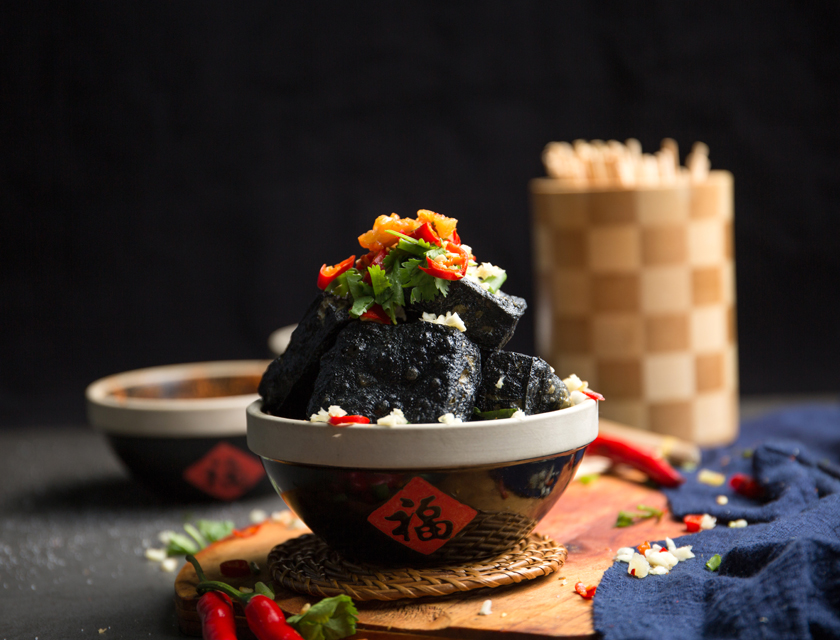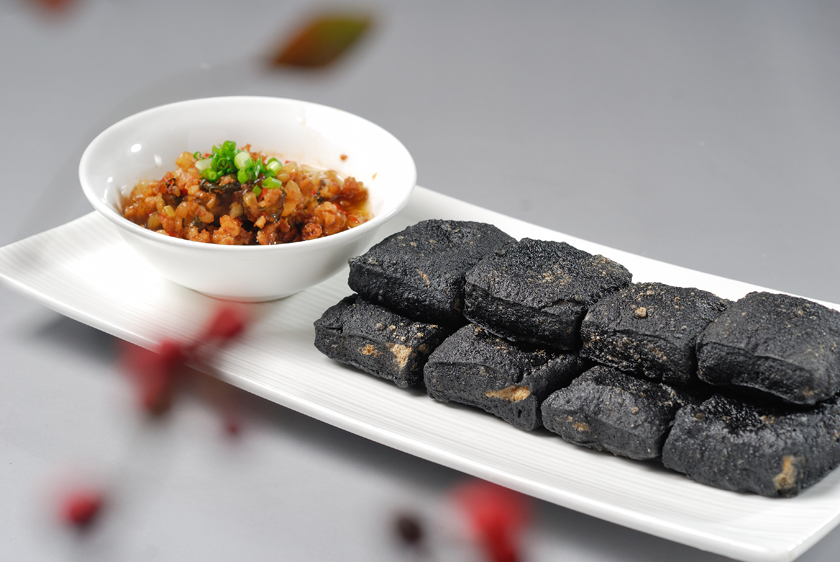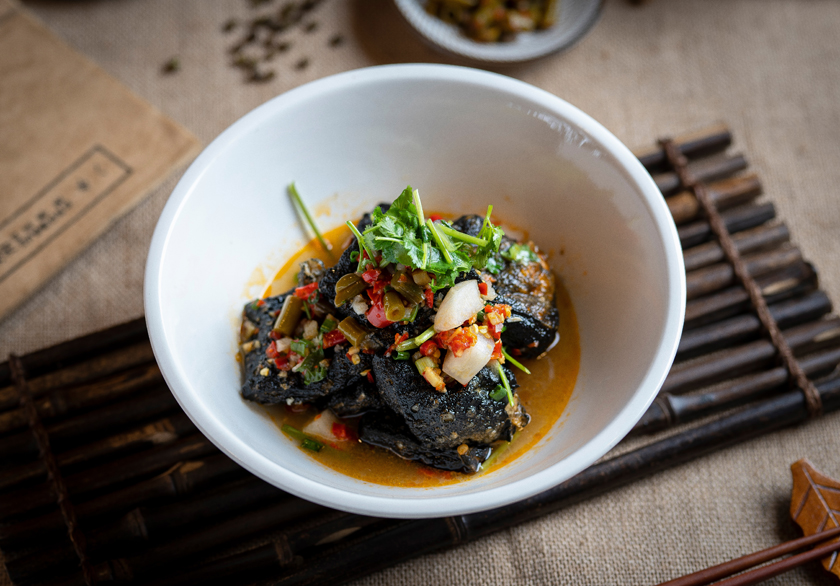What is Stinky Tofu? Exploring Why It Has a Strong One

I've been watching videos these days and saw that IShowSpeed went to Changsha, China. He even challenged the local special snack - stinky tofu. He is really brave. Let's take a look at what stinky tofu actually is and why it has such a strong smell.
What is Stinky Tofu?
Stinky tofu is a special fermented soybean product. It is made by first using soybeans as raw materials to make tofu curds, which then develop a unique flavor after being fermented by specific microorganisms.
It usually appears black or white in color. It has a crispy exterior and a tender interior. Although it has a strong smell, it tastes fragrant and delicious.
Common ways of eating it include deep-frying and then dipping it in sauce, stewing it in brine, or steaming it, often paired with seasonings such as chili and garlic juice.
As a traditional snack, stinky tofu is popular in many places in China, such as Changsha in Hunan province and Shaoxing in Zhejiang province.
Why Does Stinky Tofu Have Such a Strong Smell?
The unique smell of stinky tofu is a wonderful combination of "smelling stinky but tasting delicious".
Reasons for the stinky smell:
Microorganisms play a crucial role in the fermentation process of stinky tofu.
Microorganisms mainly including Mucor and Rhizopus decompose the proteins in the tofu, converting them into small molecule substances such as amino acids and polypeptides.
Meanwhile, some metabolic products with special odors are also produced during this process, such as sulfur-containing compounds like hydrogen sulfide and methanethiol, as well as indole and other substances. These are the main reasons why stinky tofu has a strong stinky smell.
Reasons for tasting delicious:
When you put stinky tofu in your mouth and chew it, first you feel the crispness of its outer skin, and then the smooth tofu inside.
After fermentation, the proteins in the tofu itself are decomposed into amino acids and polypeptides and other substances that are more easily absorbed by the human body, producing a strong umami taste.
At the same time, various seasonings are added during the production of stinky tofu, such as chili, cumin, soy sauce, garlic juice, etc. These seasonings further enrich the flavor of stinky tofu, giving it multiple flavor levels including salty, spicy, and fragrant. It tastes spicy and delicious, with a proper balance of saltiness and spiciness, and has a strong aroma, leaving people with a memorable aftertaste.

Who Invented Stinky Tofu?
The most widely spread story about the inventor of stinky tofu is that it was Wang Zhihe, a native of Anhui during the Kangxi period of the Qing Dynasty.
Legend has it that after failing the imperial examinations in Beijing, Wang Zhihe started making tofu to make a living.
By chance, he cut the unsold tofu into small pieces and pickled and fermented it with seasonings such as salt and Chinese prickly ash. A few days later, he found that the tofu had turned greenish-black and smelled stinky, but it had a unique flavor after tasting.
So he started making and selling stinky tofu, and later opened the "Wang Zhihe South Sauce Garden".
Why is Stinky Tofu Black?
Stinky tofu is black mainly because a special brine is used during the production process.
The brine usually contains ingredients such as fermented soybeans and copperas. The ferrous ions in the copperas react with the proteins in the tofu, generating black substances such as ferrous sulfide, which makes the stinky tofu appear black.
Where is the Most Famous Stinky Tofu From?
The most famous production places of stinky tofu include Changsha in Hunan, Shaoxing in Zhejiang, Beijing, Huizhou in Anhui, and Taiwan, etc.
Changsha Stinky Tofu in Hunan: It is famous for its unique fermentation process and strong aroma. Paired with special chili oil and sauce, the outer skin is crispy and the inside is tender and juicy. It is an iconic food in Changsha.
Shaoxing Stinky Tofu in Zhejiang: It has a long history. It is pickled with the brine of fermented amaranth stems. After deep-frying, the outer skin is golden and crispy, and the inside is as white as jade. It has a delicate texture and a unique combination of sour, sweet, spicy, and fragrant flavors.
Beijing Stinky Tofu: The Wang Zhihe brand is the most famous. It has a greenish color and a pungent stinky smell, but it tastes extremely delicious. It is a traditional special snack in Beijing.
Maofu (hairy tofu) in Huizhou, Anhui: Its surface is covered with white mycelium. After fermentation and deep-frying, the outer skin is golden and crispy, and the inside is smooth. Paired with special chili sauce, it has rich flavor layers.
Taiwan Stinky Tofu: The outer skin is crispy and the inside is porous. It has a strong flavor and is often paired with pickled vegetables and sauce. It is a popular snack in Taiwan night markets.

Is Stinky Tofu High in Calories?
The calorie content of stinky tofu is relatively high.
The specific calorie amount varies depending on the production method and ingredients.Typically, 100g of stinky tofu contains between 120 kcal to 380 kcal.
Deep-fried stinky tofu (commonly seen in street snacks):
Calories: About 250~350 kcal/100g (roughly equivalent to the calories in a bowl of rice).
Reason: During the deep-frying process, the tofu absorbs oil (the oil absorption rate can reach 10% - 20%), and the high temperature causes water evaporation, increasing the calorie density.
Steamed/non-fried stinky tofu:
Calories: About 120~180 kcal/100g (roughly double the calories of regular tofu).
Reason: After fermentation, part of the protein is decomposed, but no oil is added. The calories mainly come from the protein and a small amount of fat in the tofu itself.
Is Stinky Tofu Harmful to the Body?
Stinky tofu itself is not harmful to the body, especially when it is hygienically produced and the ingredients are fresh.
Like other types of street snacks, for most people, eating stinky tofu occasionally is completely fine. Especially when enjoying the delicious food, an appropriate amount of oil and salt will not cause too much burden on the body.
However, if you have health problems such as high blood pressure, heart disease, or are managing your weight, it is recommended to minimize the intake of fried foods and high-salt foods.
How to Make Stinky Tofu (Homemade Version)
Ingredients
Main ingredient:500 grams of firm tofu
Brine ingredients:
200 grams of Chinese cabbage/amaranth stems (providing fermentation bacteria)
500 milliliters of clean water
30 grams of salt
10 Chinese prickly ash seeds, 1 small piece of cinnamon, 1 star anise (to enhance the aroma)
3 slices of ginger, 3 cloves of garlic (to inhibit bacteria and enhance the flavor)
Steps
1. Make the basic brine
Boil the vegetable water:
Cut the Chinese cabbage/amaranth stems into sections, add clean water, bring to a boil, then turn to low heat and boil for 15 minutes. Strain out the vegetable water.
Prepare the brine:
Add salt, Chinese prickly ash seeds, star anise, cinnamon, ginger slices, and garlic cloves to the vegetable water. Bring to a boil, then turn off the heat and cool to room temperature.
2. Prepare the tofu
Cut the tofu into small squares about 2 cm thick and blot the surface moisture with kitchen paper.
Steam the tofu for 5 minutes after the steamer starts to steam to make the tofu firmer (reduce fragmentation after fermentation).
3. First fermentation
Soak in the brine:
Put the tofu cubes into a sterilized glass jar and pour in the cooled brine (to cover the tofu).
Seal and ferment:
Cover with breathable gauze (or make holes in plastic wrap) and ferment at room temperature (25 - 30°C) for 2 - 3 days.
Observation: Success is indicated when white or grayish-white mycelium appears on the surface, the liquid becomes turbid, and a faint stinky smell is emitted.
4. Second fermentation (enhance the flavor)
Change the brine and enhance the flavor:
Pour out the first brine and prepare a new brine (reduce the amount of salt by half, and you can add a small amount of white wine for disinfection).
Deep fermentation:
Soak the tofu in the new brine, seal it, and refrigerate for 1 - 2 days for a more mellow flavor.
5. Cooking and serving
Classic deep-fried version:
Gently rinse the mycelium on the surface of the fermented tofu with clean water and drain the water.
Fry in oil at 180°C (when a chopstick inserted into the oil makes small bubbles) until golden and crispy (about 3 - 5 minutes).
Poke holes and add sauce: Chili sauce + mashed garlic + coriander + light soy sauce + vinegar.
Healthy steamed version:
Put the tofu directly on a plate, drizzle with sesame oil + chopped chili peppers, steam for 10 minutes, and sprinkle with scallions.

The Cultural Significance of Stinky Tofu
Stinky tofu was initially popular among the people perhaps due to thrift (to avoid wasting spoiled tofu). Later, due to its unique flavor, it was gradually accepted by all classes and even became a local cultural symbol. For example:
Stinky tofu at Huogongdian in Changsha became famous because of Mao Zedong's comment "smells stinky, tastes delicious".
Night markets in Taiwan combine stinky tofu with innovative eating methods (such as steaming and spicy flavors), giving it modern vitality.























